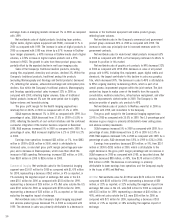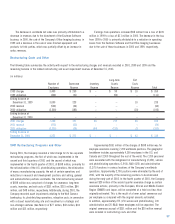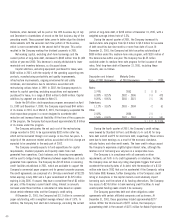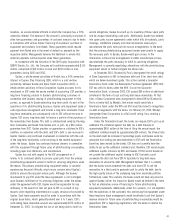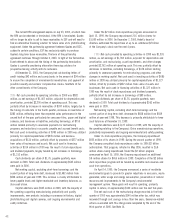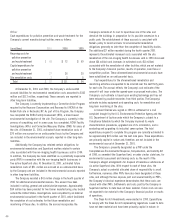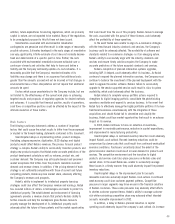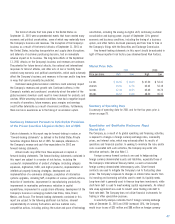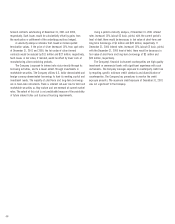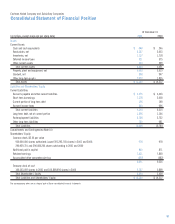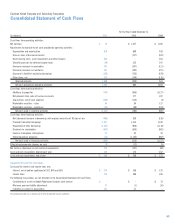Kodak 2001 Annual Report Download - page 47
Download and view the complete annual report
Please find page 47 of the 2001 Kodak annual report below. You can navigate through the pages in the report by either clicking on the pages listed below, or by using the keyword search tool below to find specific information within the annual report.
45
addition, future expenditures for existing regulations, which are primarily
capital in nature, are not expected to be material. Many of the regulations
to be promulgated pursuant to this Act have not been issued.
Uncertainties associated with environmental remediation
contingencies are pervasive and often result in wide ranges of reasonably
possible outcomes. Estimates developed in the early stages of remediation
can vary significantly. A finite estimate of cost does not normally become
fixed and determinable at a specific point in time. Rather, the costs
associated with environmental remediation become estimable over a
continuum of events and activities that help to frame and define a
liability and the Company continually updates its cost estimates. It is
reasonably possible that the Company’s recorded estimates of its
liabilities may change and there is no assurance that additional costs
greater than the amounts accrued will not be incurred or that changes in
environmental laws or their interpretation will not require that additional
amounts be spent.
Factors which cause uncertainties for the Company include, but are
not limited to, the effectiveness of the current work plans in achieving
targeted results and proposals of regulatory agencies for desired methods
and outcomes. It is possible that financial position, results of operations,
cash flows or competitive positions could be affected by the impact of the
ultimate resolution of these matters.
Risk Factors
The following cautionary statements address a number of important
factors that could cause the actual results to differ from those expressed
or implied in the forward-looking statements contained in this document.
Unanticipated delays in implementing certain product strategies
(including category expansion, digitization, OLED displays and digital
products) would affect Kodak’s revenues. The process for each product
strategy is complex. Kodak’s ability to successfully transition products and
deploy new products requires that Kodak make accurate predictions of the
product development schedule as well as volumes, product mix, and
customer demand. The Company may anticipate demand and perceived
market acceptance that differs from the products realizable customer
demand and revenue stream. In addition, if the pricing element of each
strategy is not sufficiently competitive with those of current and future
competing products, Kodak may lose market share, adversely affecting
the Company’s revenues and prospects.
Kodak’s ability to implement its intellectual property licensing
strategies could also affect the Company’s revenue and earnings. Kodak
has invested millions of dollars in technologies and needs to protect its
intellectual property. The establishment and enforcement of licensing
agreements provides a revenue stream that protects Kodak’s ability to
further innovate and help the marketplace grow. Kodak’s failure to
properly manage the development of its intellectual property could
adversely affect the future of these patents and the market opportunities
that could result from the use of this property. Kodak’s failure to manage
the costs associated with the pursuit of these licenses could adversely
affect the profitability of these operations.
In the event Kodak were unable to align its e-commerce strategies
with the trend toward industry standards and services, the Company’s
business could be adversely affected. The availability of software and
standards related to e-commerce strategies is of an emerging nature.
Kodak’s ability to successfully align with the industry standards and
services and ensure timely solutions requires the Company to make
accurate predictions of the future accepted standards and services.
Kodak’s completion of planned information systems upgrades,
including SAP, if delayed, could adversely affect its business. As Kodak
continues to expand the planned information services, the Company must
continue to balance the investment of the planned deployment with the
need to upgrade the vendor software. Kodak’s failure to successfully
upgrade to the vendor-supported version could result in risks to system
availability, which could adversely affect the business.
Kodak intends to complete various portfolio actions required to
strengthen its digital imaging portfolio, consolidate the photofinishing
operations worldwide and expand its services business. In the event that
Kodak fails to effectively manage the highly profitable portfolio of its more
traditional businesses simultaneously with the integration of these
acquisitions and should Kodak fail to streamline and simplify the
business, Kodak could lose market opportunities that result in an adverse
impact on its revenue.
In 2002, Kodak continues to focus on reduction of inventories,
improvement in receivable performance, reduction in capital expenditures,
and improvement in manufacturing productivity.
Unanticipated delays in continued inventory reduction could adversely
impact Kodak’s cash outlook. Planned inventory reductions could be
compromised by slower sales that could result from continued weak global
economic conditions. Purchasers’ uncertainty about the extent of the
global economic downturn could result in lower demand for products and
services. The competitive environment and the transition to digital
products and services could also place pressures on Kodak’s sales and
market share. In the event Kodak was unable to successfully manage
these issues in a timely manner, they could adversely impact the planned
inventory reductions.
Unanticipated delays in the improvement plan for accounts
receivable could also adversely impact Kodak’s cash outlook. A continued
weak economy could slow customer payment patterns. Competitive
pressures in major segments may drive erosion in the financial condition
of Kodak’s customers. These same pressures may adversely affect efforts
to shorten customer payment terms. Kodak’s ability to manage customer
risk while maintaining competitive share may adversely affect intended
accounts receivable improvement in 2002.
In addition, a delay in Kodak’s planned reduction in capital
spending could adversely impact the company’s cash outlook. An increase



